Since we originally designed and built the Weekly SuperIndex recession model, we have created fourteen other quantitative recession models for clients over the last decade. These range from broad-based short, medium, and long-term composite leading & coincident economic indicators to composites focused on Housing, Labor, Gross Domestic Product & Income and Valuations.
Each of these fifteen diversified recession models are combined into a Diffusion representing how many of them are in their respective recession territories, to form the Recession Forecasting Diffusion (RFD) which ranges from 0 to 15.
The RFD is thus a collection of fifteen powerful diversified recession forecasting methodologies that differ in data, mechanics, approach and theory to offer us an over-arching recession dating and forecasting methodology that is resilient to individual “model risk”.
There is no “one size fits all” mathematical model that performs well in the past and is guaranteed to perform well into the future. Every recession is different and since recession calls are “high stakes” events, with costly consequences for either calling a recession when there is none (as with the recent ECRI call that cost investors who heeded it 28% in lost stock market gains) or failing to call a recession and getting caught in the average 30% recessionary draw-down, we need to be very sure when we make a call. The only way to do that is by consulting multiple robust models that are not too correlated with each other in makeup or methodology. If one, two or even three of these models “fail” we have the other models as backup.
The fifteen models that make up the RFD are listed below:
Coincident Models
- National Buro for Economic Research (NBER) “Big-Four” Model
- Gross Domestic Product and Income model (GDPI)
- The SuperIndex Diffusion
- The SuperIndex Coincident Composite
Short-Leading Models
- The Anxious Index
- The SuperIndex Leading Composite
- The U.S Leading Labor Market Index
Medium-Leading Models
- SuperIndex Recession Syndrome model
- Composite Market Health Index (CMHI)
- The Stylized Headwinds Index
- The Weekly Leading Economic Index (WLEI)
- The U.S Monthly Leading Economic Index (USMLEI)
Long-Leading Models
- The US Housing Market Composite (USHMI)
- The RecessionALERT Valuation Index (RAVI)
- The US Monthly Long-Leading Economic Index (USLONG)
Each of the above are sophisticated, powerful recession forecasting models in their own right, but they vary in the lead warning times to recession. As a general rule, the longer the lead warning a model offers the more likely it is exposed to possible error or inaccuracy. Therefore, the RFD obtains resilience by using leading and co-incident models.
RFD Index
The Recession Forecast Diffusion merely counts how many of the 15 models are flagging a recession, and is depicted below: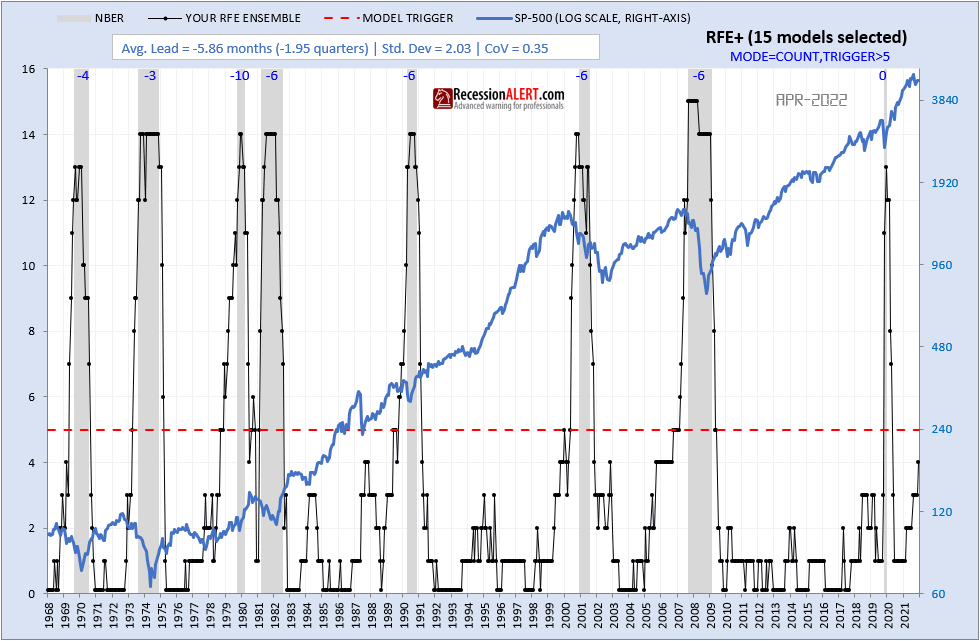
We have configured an optimum actionable trigger for the RFD of > 5 (at least six models in recession) to achieve best lead time (6 months) with least variability (2 months) and zero false positives or negatives. Dividing the standard deviation of lead time by the lead time itself gives a coefficient of variance of 0.35 (lower the better) which compares second best among all the 15 individual model components as shown below:
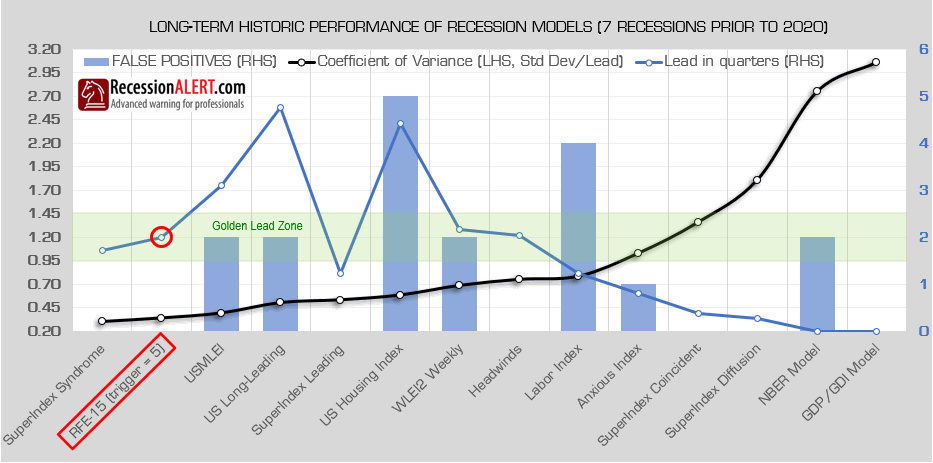
*CMHI excluded from comparison due to too many false positives and RAVI excluded as history less than 7 recessions.
More importantly, the RFD falls into the “Golden Lead Zone” of 1.5-2.5 quarters (4.5 to 7.5 months) which is the optimum recession warning for stock market returns according to detailed research we have done in “Recessions: Just how much warning is useful anyway?”
This confirms all previous research we have done that shows ensembles (or diffusions) have far better recession forecasting performance characteristics than any of the individual models making up their components. Notwithstanding that they are less susceptible to individual “model risk.”
Mapping probabilities & lead-times to recession
We can determine the probabilities of a U.S recession within 6, 12, 18 and 24 months for each RFD level by counting in history how many of the dots of a specific RFD level fall within 6/12/18/24 months of the start of a past US recession and divide that by the total number of points witnessed of a specific RFD level. This yields the following table:
We note that at an RFD reading of five, probabilities of a recession within 12 months rise dramatically from 27% to 87%. It also makes sense that the further out we look, the higher the odds we should be expecting of a recession.
We see from the above chart that whilst an RFD reading of 5 almost guarantees (at least historically) a recession on the 12-, 18- and 24-month timeframes, we have selected an action trigger above five (at least six models in recession.) This provides the “optimum” lead time of 6 months to recession (not too soon, not too late) whilst also reducing the odds of a potential false positive – a viable threat for any recession model. Being too early or exiting the market unnecessarily if there is no recession are costly exercises in term of lost potential market gains, especially in late bull cycles and we feel it therefore prudent on a risk/reward basis to give the economy the benefit of the doubt with an extra RFE level.
We can use this table to map out the probabilities on a timeline:
We see that at the current RFD level of 4 (RAVI, CMHI, HOUSING and our USLONG Long-Leading Composite are in recession) the odds of recession in 12 months is 27%, in 18 months is 58% and in 24 months is 81%.
Access to updates of RFD
The prior chart is updated together with an alert for subscribers whenever the RFD rises. Subscribers can access the chart from the RFD tab in the Dashboard menu as depicted below:
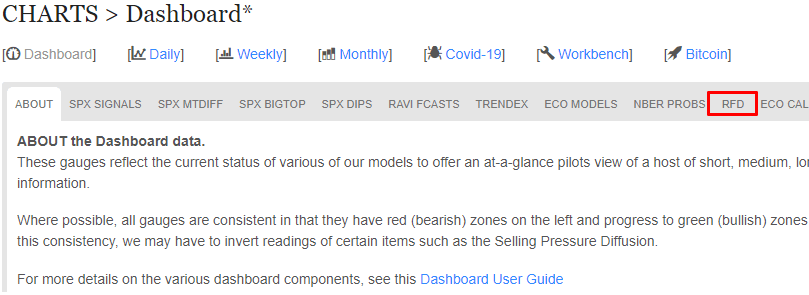
You can also access the RFD reading by clicking on the “ECO MODELS” tab in the Dashboard menu, where it is shown as a gauge labeled “RFD-15“:
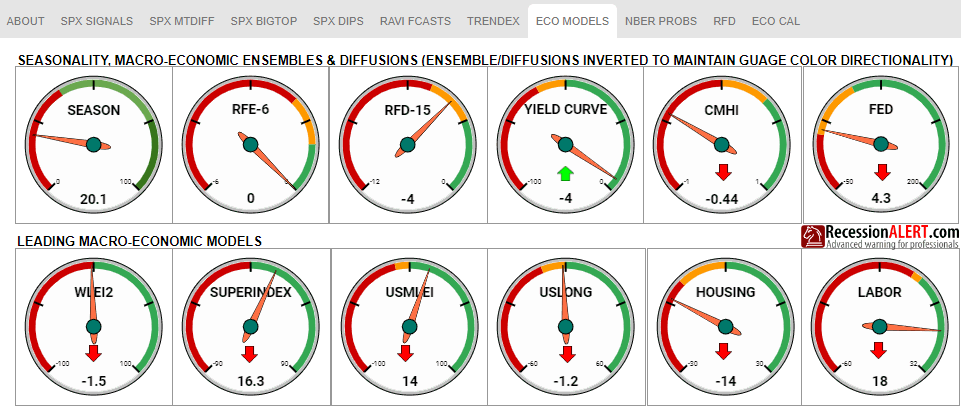
Of course, the RFD has been available to PRO subscribers in the Monthly Excel Data Download for many years now. You can access its chart and its historical data from the “Monthly PRO Excel Data File” at https://recessionalert.com/excel-data/

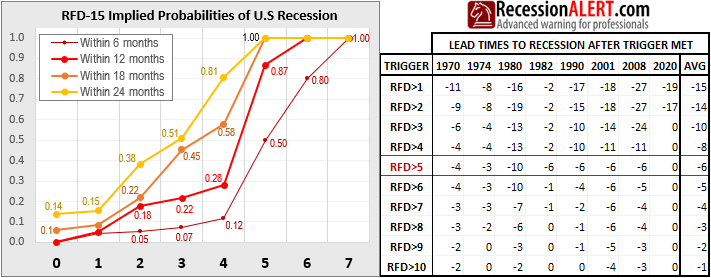
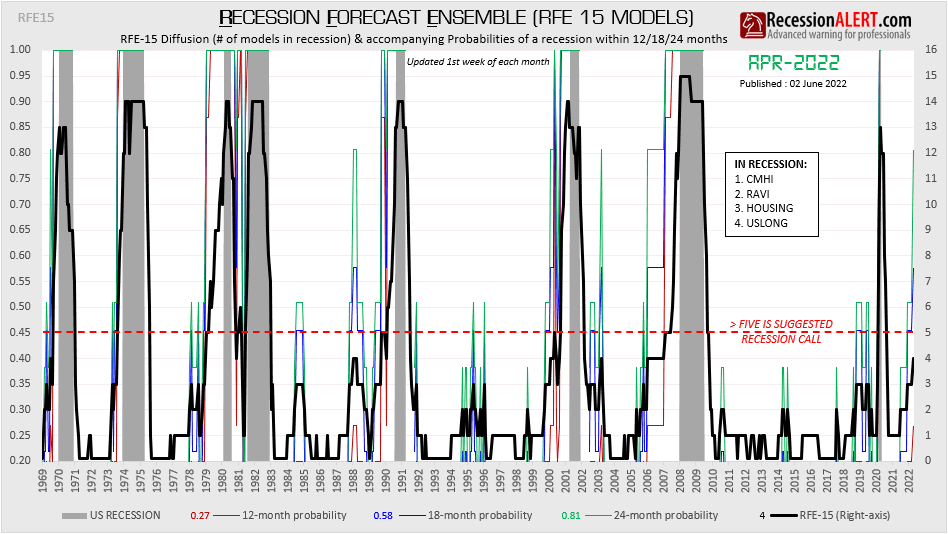
Comments are closed.